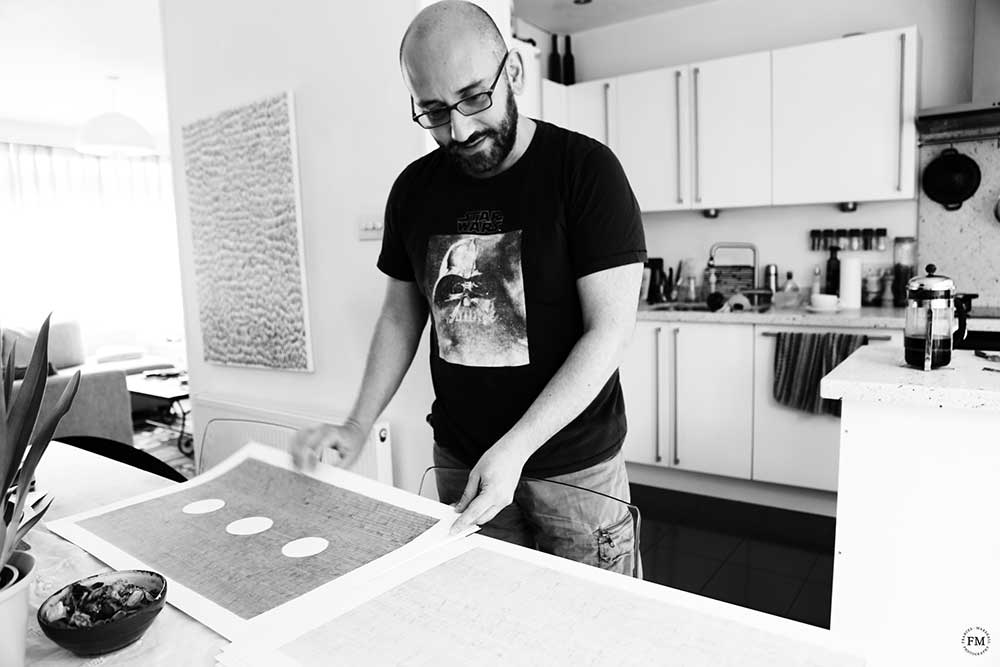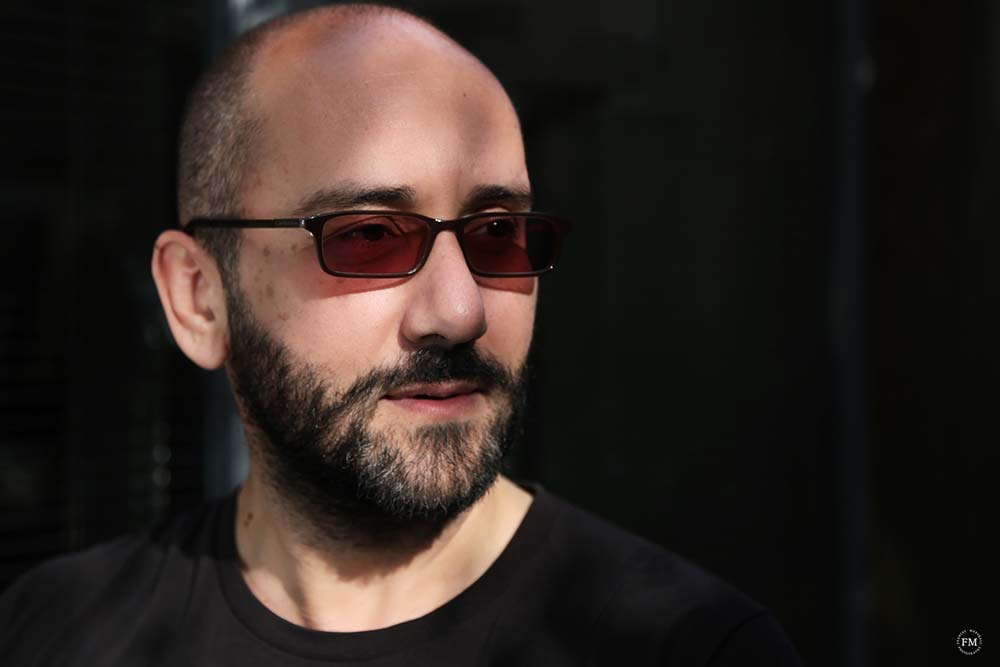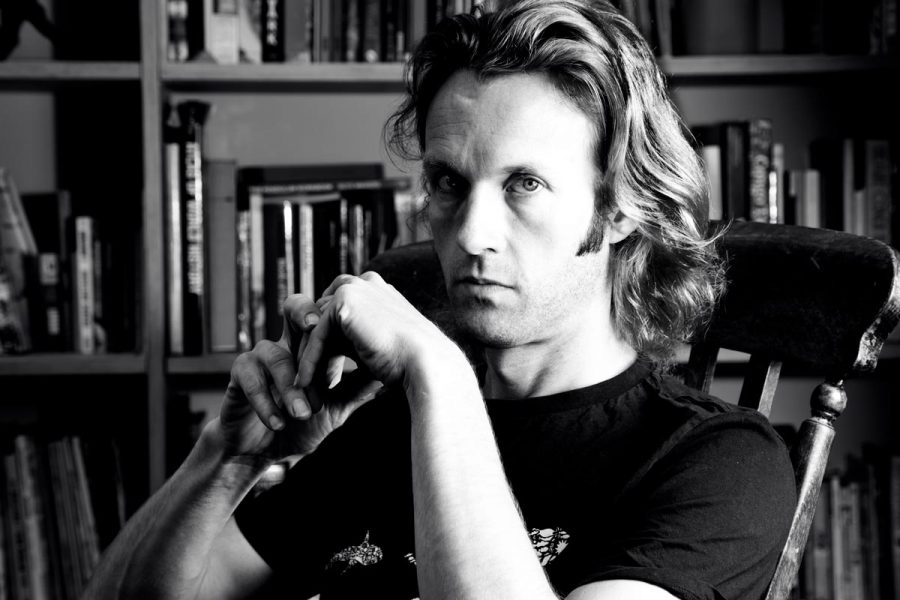Composer’s Corner: Haris Kittos

June 2016
Words by
Emer Nestor
Photos by
Frances Marshall
Greek composer and visual artist Haris Kittos is currently Professor of Composition at the Royal College of Music in London. His music has been performed throughout the UK and abroad by a variety of artists including Arditti Quartet, dissonArt, Ensemble Exposé, ExplorEnsemble, Fukio Ensemble, Milos Karadaglic, London Sinfonietta, Jane Manning, Sarah Nicolls, and UMS ‘n JIP.
Final Note chats to Kittos about studying music in Thessaloniki, the move to the UK, his work at the RCM, the relationship between music and art within his creative process, and his recent involvement in the Adrift project as part of InTRANSIT Festival in South Kensington.
Take us through the musical sounds of your upbringing in Thessaloniki.
When I was a child it was quite a mixture, because my parents loved music of various styles—classical, Greek (mainly folk and rembetika) and even 70s pop music, like Abba! But my attraction quite soon turned towards classical music and I became less fond of pop, especially disco (which I eventually appreciated in my mid 30s!), maybe as a reaction to my brother—I remember as a teenager listening to Bach’s organ music downstairs, while he was playing Michael Jackson loudly upstairs…my poor parents!
I wasn't 100% sure what I wanted to do...it felt impossible to choose between music and visual art."

Which came first, the desire to write music or the desire to draw/paint?
I’ve been painting since I remember myself, probably because it’s easier to just give paper and pencils to a child. Then my parents bought us an electric keyboard when I was 10, and brought a piano teacher to our home. But this was only meant to be a hobby. I happened to be the ‘clever’ one in the family because I was doing ok in school, and dad wanted me to become a dentist, like him. The problem was that I got more and more passionate about piano, and at the same time I was drawing architectural designs and already producing big oil paintings! Somehow all this came together and created a growing urge to write music.
Having attended the Macedonian Conservatoire and the School of Arts, Aristotle University, why did you choose to further your music education at Trinity College of Music?
When I was finishing my studies in Thessaloniki in the mid 90s, I felt a strong urge to expand my horizons beyond a small country like Greece. Also, because of the music education system there (I had studied harmony, counterpoint, fugue and orchestration for 7 years without any composition lessons), I had had enough! In the meantime, I had visited London already because I was interested in studying postgrad piano there but I wasn’t 100% sure what I wanted to do…it felt impossible to choose between music and visual art. But when I got a letter from the Greek army saying that I had to join the military immediately after obtaining the University degree, I had to act quickly because I detested the idea of postponing my studies in order to become a part of the war-making industry for almost 2 years (military service in Greece is half this length now). So, I sent some of my compositions to TCM because I knew it was a friendly, welcoming place AND the only college with late submission deadline, and I got a place there just a week before I had to join the army!
At postgraduate level, you studied with a variety of musical figures such as Andrew Lovett, Daryl Runswick, Diana Burrell, Theodore Antoniou, Susan Bradshaw, Beat Furrer and Alexander Goehr — what have you taken from working with such an eclectic mix of people?
Andrew Lovett, Daryl Runswick and Diana Burrell were my principal study tutors in TCM and Guildhall—each with lots of experience from different musical backgrounds and all of them fantastic teachers…very open-minded and supportive. Susan Bradshaw was a close friend and mentor; we first met in a piano masterclass in Thessaloniki and, after I moved in London, I used to go to her house in Islington every week, where we would go through her huge music library and discuss everything about composition. She was an amazing person, who influenced me hugely and I miss her dearly (she passed away in 2005).
As for the great composers Aperghis, Antoniou, Furrer and Goehr, I worked with them in masterclasses and private sessions during or after finishing my studies; hearing their view of music and career in composition, plus receiving their feedback and advice, was invaluable.
Overall, I think that working with such diverse musical figures was instrumental in my development as a composer, especially because I was a late starter (I started composing more ‘seriously’ in my late 20s). As there was so much to learn and catch up within a relatively short time, this was the best way, for me, to form a more spherical perception of composition and music of our time.
How did the DMus programme in composition at the Royal College of Music influence your approach to writing music?
The topic that I chose to focus my research on (Xenakis’ Sieves theory) was fascinating, and I turned my composition into a ‘laboratory’ through which I would develop and demonstrate my findings. This made me feel increasingly pressured to explain and justify everything I composed, so I got stuck for some time, as I was rarely happy with any results. However, with the help from my supervisors, Julian Anderson and Edwin Roxburgh, I gradually became more confident and ‘broke free’. This allowed be to realise my own process and understand what ‘works’ for me in musical composition, without worrying about how to justify what I write theoretically, or explain which complex system I am using etc…. So, on the one hand, maybe the DMus slowed me down in terms of artistic production and career but, on the other hand, it made me more self-aware and stronger, but also more focused and independent as a musician.



Did your time at the RCM inspire you teach at third level or was this always the plan?
I was always aware that it is rare for a composer like me to earn their living entirely from composing. So, I taught privately and in schools for years, which was lovely, but I felt that I had more to give. However, I wasn’t really planning something specific; it was just a dream to be able to pass the knowledge that I had gained in all the years of my studies to students at a higher level. Then, when I arrived at the RCM, Dr Darla Crispin (Head of Postgraduate Studies at the time and also my academic supervisor) had established a system of offering graduate assistant teaching posts to doctoral students as part of their training. This was an incredible opportunity and I loved every moment of it, so it felt natural to continue teaching at tertiary level when RCM offered me a more permanent professorship.
As a member of the academic faculty of the Royal College of Music, how do you prepare students for a career in composition?
I have two separate posts in RCM. The first is composition teaching one-to-one, mainly for principal study students. The second post is academic: teaching classes inhistory of avant-garde music, harmony and aural training, plus doctoral supervision. I also lead the Contemporary Music in Action module, where we bring players and composers together to create new works. This is one of the fantastic projects in college that gives the students the chance to collaborate and gain practical experience—which, for composers, is essential for their development, as it’s so important for us to hear our music played! So, specifically when working with young composers in RCM, the main aim is to help them develop a strong technique AND bring out individuality in their musical language, so that they are not only skilled on a professional level when they finish their studies, but also confident and artistically conscious.
Do you have a particular process that you follow when writing a new piece of music?
This really depends on what or who the new piece I am writing is for…not only the combinations of instruments and sounds, but also the actual performers and/or other people who commission me. Sometimes I might know already what the piece is about and what I want to say, which can also derive from the nature or theme of the project. And sometimes, it just reveals itself to me gradually. Usually, by meeting the musicians and getting to know them, a simple idea might come into my head first, a gesture or sound which can even appear while trying things together in workshop or rehearsal. Then I develop this idea or ideas mostly ‘organically’ into a piece. Overall, I am trying to listen to the needs of the piece as it ‘grows’, without imposing a style, system or form on it, while allowing all my technical skills and experience accumulated over the years to work together in a rather instinctive way. Also, I quite often like to revise a piece after I hear its premiere because, for me, it’s a thing that continues to evolve and begins having its own life.
How does the way in which you hear music influence your style of drawing/painting?
For me, music is about sound that carries colour, texture, gesture, drama and architecture in time, creating meaning. This is the same with visual art, which is about light that carries the same aspects but in space. So, the ways I experience these two media have lots of parallelisms. This means that it is inevitable that one does feed into the other. But, this happens on an intuitive, instinctive level, not anything programmatic, and I’ve never really tried to mix them; they are very different ways of communicating, with very different languages and states of mind, and I really enjoy working on each separately, mentally and physically, with no compromises on style or quality.
From where do you derive inspiration?
Everywhere, to be honest. It’s people, everyday life, society, politics, concerts, teaching, Internet, plus lots of books, poetry, and lots of movies! For example, I am currently very much into reading the poetry of Andreas Empeirikos, a 20th-century Greek Surrealist poet, who was a friend of André Breton and was the first person to introduce psychoanalysis to Greece.
Overall, I am trying to listen to the needs of the piece as it 'grows', without imposing a style, system or form on it..."



The idea for Adrift centred on a moving installation of people inside a big space in South Kensington."

Tell us about your recent involvement in the Adrift project in South Kensington.
Harry Ross, who is running InTransit festival with Helen Scarlett O’Neil, asked me if I wanted to be involved with a project for community choirs for the refugee week in South Kensington; this was partly because I am Greek—I’ve seen lots of refugees in the streets of Athens and Thessaloniki who arrive from the islands or nearby camps. But also in fact, I myself come from refugee families too: my maternal grandparents were from Greek communities in Turkey, who had to flee after WWI and lost everything. On the other side, my paternal grandmother’s family was deported from Yugoslavia to Greek Macedonia, while my granddad Kittos was an immigrant teacher from a village in Cyprus that is now on the Turkish side.
Additionally, I teach in RCM, which is part of the South Kensington local community. So this was a unique opportunity to create music with local people (the choir is made up of groups from Sing to Live, Live to Sing) and make it a direct reaction to what’s happening in Europe at the moment. I also asked two of my RCM composition students, Lillie Harris and Dan McBride, to join me in the project, as they are both not only very talented with lots of fresh ideas, but they also have experience with outreach workshops and collaborating with various community activities.
The idea for Adrift centred on a moving installation of people inside a big space in South Kensington. So we immediately decided to have the choir singers walking while singing; in other words, a symbolic walk with groups of people drifting between destination points, forever searching. Also, we decided to keep it simple, just people walking and singing, with no additional effects or gimmicks.
The musical material for the piece came together with a full-day workshop that we did in May with the whole choir in the V&A Auditorium. This workshop was instrumental in deciding how to devise simple actions for the singers and put them together with aleatoric techniques in an open score. So the score was actually a list of instructions, four sets of musical actions and gestures, and plans for the walking routes—all memorised by the choir leaders, because we didn’t want the singers to have to carry a score while walking.
Overall, the choir splits into groups while performing an initial set of musical gestures. Then they walked from one point to the other, where they then stopped and, after a minute’s silence, started singing the next set of musical material and began to walk to the next destination point, and so on. I hope that it was a haunting piece that in some way reflected the travels and struggles of people who are forced to search for a safe place to live their lives.
What’s next for you?
This is a period where I am grateful to have relative stability in my life and work, as I am enjoying doing new projects with ensembles and soloists, while teaching in such an exciting place as the RCM. In terms of composition, at present I am working on an orchestral piece, while preparing a new collaboration with Ensemble Mise-en in New York. I’m also developing solo projects with performers from Norway and Spain. In terms of visual art, I am working on a series of coloured drawings using specialist marker pens, which I aim to combine with pencil drawings. My aim is to complete a substantial portfolio for solo exhibition.
To find out more about Haris Kittos see: intransitfestival.co.uk
Further information on the Adrift project is available at: www.rbkc.gov.uk
Share this article





